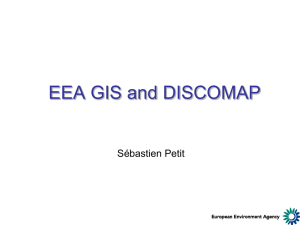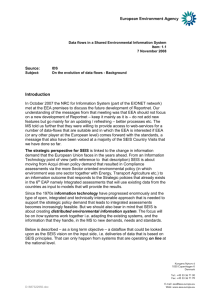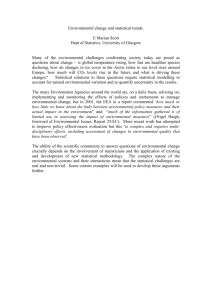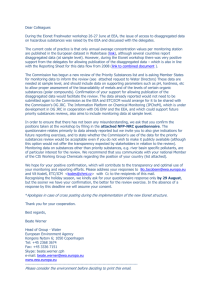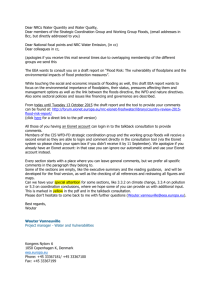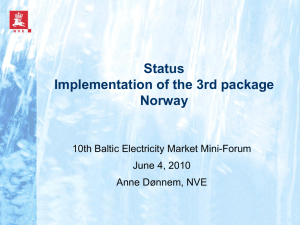Reportnet brochure
advertisement
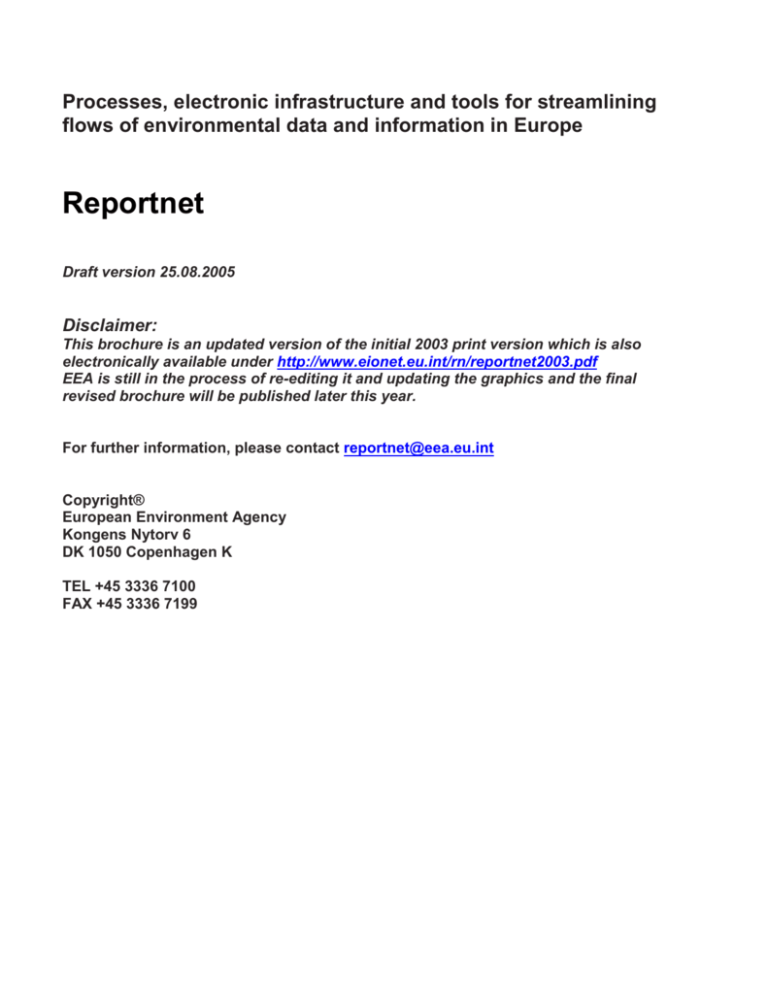
Processes, electronic infrastructure and tools for streamlining flows of environmental data and information in Europe Reportnet Draft version 25.08.2005 Disclaimer: This brochure is an updated version of the initial 2003 print version which is also electronically available under http://www.eionet.eu.int/rn/reportnet2003.pdf EEA is still in the process of re-editing it and updating the graphics and the final revised brochure will be published later this year. For further information, please contact reportnet@eea.eu.int Copyright® European Environment Agency Kongens Nytorv 6 DK 1050 Copenhagen K TEL +45 3336 7100 FAX +45 3336 7199 Reportnet - streamlined processes and a shared information infrastructure to support environmental policy making in Europe EEA and its member countries are collaborating on Reportnet because the flows of information from countries to the international level, and back again, are important for understanding environmental progress. The flows are primarily linked to targets and measures defined in European Union legislation, international conventions and protocols and in EEA’s targets. Information is needed on issues such as the causes of pollution, the status of bio- diversity, the environmental performance of sectors and the effectiveness of actions. Such information is used to describe trends and model futures, thereby helping countries and European institutions to formulate more effective policies. Reportnet is currently focusing primarily on flows from member states to the EEA. The long-term vision is to develop an infrastructure allowing multiple data requestors at national and international levels access delivered data and retrieve part for own targets and measures. This principle is shortly described by ‘Deliver-once-use-by-many’. Steadily increasing reporting obligations Reporting obligations agreed between EU and international bodies and countries provide the framework for information flows. This framework has grown in Europe as the Commission and the Member States have agreed reporting requirements for separate laws or sectors, in most cases independently of one another. Member States are also required to respond to a myriad of non-legal (moral) obligations, mainly emanating from EEA, Eurostat, OECD and United Nations. Duplication of efforts, together with the lack of a transparent, need-based approach to information flows, have contributed to poor response rates to main reporting obligations. 0 20 40 60 80 100 120 140 160 180 Acidification Air Quality Biodiversity Change and Nature Chemicals Climate Change Natural Resources Noise Ozone Depletion Soil EU Convention UN OECD Various other issues Waste Water Towards a balanced and efficient European reporting system EU's Sixth Environmental Action Programme (6EAP) recognises the need to revise the reporting system in order to achieve a clearer specification of policy-relevant information needs to increase transparency and to remove overlaps and duplications. The programme highlights that solutions enabling a more transparent and efficient flow should be enabled, and that suitable IT developments should be exploited. Information flows and indicators in EEA For the EEA and EIONET, most interest in information flows centres on the collection and organisation of data on the state of the environment, and associated driving forces, pressures and impacts. The supplied data is used to produce and analyse indicators, including those for assessing the effectiveness of policies. The EEA has developed, with countries, a core set of indicators covering: Environmental issues: water stress, air pollution, climate change, biodiversity and nature protection, soil and land issues, waste and material flows Economic sectors and environment: transport, energy, agriculture, tourism, fisheries The indicators are gradually implemented over the period 2004-2008, and will provide the main focus for information flows in Reportnet between countries and the EEA. Data quality processes Reportnet addresses data quality in two different ways and in two different phases of the reporting cycle. The first process, which is being implemented data flow by data flow is the automated quality assurance (QA 1). During this process of uploading data to the central data repository via the appropriate service of the generic data exchange module, the deliveries are checked against the data dictionary and feedback is given to the data supplier should there be inconsistencies with the data dictionary entries. A second QA step (QA 2) is applied while merging the national deliveries have into a draft European dataset using conversion and merging tools and before entering it into the European data warehouse (in many cases the EEA data service). At this point, the thematic experts take a close look at this draft dataset and communicate necessary changes with the data suppliers which might lead to a revised upload. Reportnet – streamlined functions for environmental data exchange Reportnet is both an information infrastructure and a new setup of functions to assist data and information flows resulting from reporting obligations. It is currently mainly being used for reporting to EEA, hosting some of DG Environments reporting tasks. The open system allows deliveries also to other national and international organisations. Reportnet builds on active use of the World Wide Web. The system integrates different web services and allows distributed responsibilities. Reportnet secures that delivered data are made quickly available for analysis, and in addition, if conditions allow for it, publicly available without delay. It is a contribution to what is a shared challenge for European countries, their networks of institutions and EU institutions - to develop technical and organisational systems which facilitate streamlined, transparent and shared use of multipurpose data and information. Components of Reportnet and the main data flow. The inner (red) circle illustrates normative and metadata components, the outer ring the main 'real' data flow. Which functions do Reportnet tools have? Reportnet can contribute in several ways to more effective data/information flows; It can provide a web catalogue of reporting obligations to the countries' planning (ROD reporting obligations database show reporting obligations for a country. http://rod.eionet.eu.int ) This catalogue can also act as a portal to necessary detailed information for those delivering data on a specific obligation. It has links to guidelines, links to technical specifications of data to be delivered, links to contact information of institutions and persons responsible for deliveries in countries, and has links to the underlying legislative acts or conventions. It can provide on selected main obligations detailed specifications of data to be delivered, delivery templates in agreed formats, and guidelines (data dictionary http://dd.eionet.eu.int/ ) It can provide smart software to make data provision by countries easier, more comparable, quality assured and fully audited (generic data exchange modules GDEM, where necessary specialised data exchange modules for PCs, e.g. AQ-DEM and AE-DEM) It can store delivered data/information in one place for easy reference and for archiving over time (CDR central data repository, http://cdr.eionet.eu.int/ ) It can provide means for tracking the status of deliveries on an obligation and accessing deliveries (status of deliveries-functionality in ROD-obligation, search in CR content registry, http://cr.eionet.eu.int/) And it can provide the means for other international organisations and countries to use other countries' information for their own assessment needs. (CDR central data repository). In these ways Reportnet contributes also to Europe's eGovernment activities in the environment sector. Deliver once - use by many: a system for multiple use Countries also deliver data and work with Eurostat, DG Environment, other DGs, OECD, UN, and international conventions, being major users of delivered data. These international institutions are also seen to have a shared interest in improving the delivery process and reducing countries’ burden of delivering overlapping data with numerous different methods and tools. For the future it will be a joint challenge for the European countries and the international institutions to maintain a coherent infrastructure for information flows delivering multipurpose data files. EEA and the member states work together to have Reportnet contribute to this challenge. They are making data and information available, so as to maximise their multiple use and value. As a result countries are able to deliver with higher response rates more timely and better quality data for more numerous targets. Reportnet users – our key asset Reportnet addresses people active in the delivery chain from national to international levels. Users can be classified in different groups based on their roles. Data supplier and National co-ordinator are roles on the national level. Data definers, Dataflow managers, Data collectors, and actors organizing assessments and information provision are roles of an international institution requesting data from countries, e.g. EEA, The tools are designed to meet both national and international needs. 1. Data definers Reporting obligations are agreed at national, European and global levels and enforced in a legislative instrument. In the work of defining obligations, committees and working groups may get help in Reportnet, where the overall picture of the existing obligations, and requested data can be found. As Reportnet in addition contains standards, nomenclature and definition of elements and codes for existing requirements, this source material can be consulted and reused. Reportnet can also be used in the negotiation phase on new potential obligations as a central platform for maintaining and making available draft data specifications and guidelines. After approval the new obligation and approved specifications are ready for publishing in Reportnet and later for using in managing dataflows on that obligation. EEA’s Data definers in its topic centres (ETCs) maintain obligation data for EEA’s priority data flows in ROD and data specifications on the flows in data dictionary. They also define quality analysis rules for automatic quality review of each requested data set. A new way to create individual entries to the set of Reportnet tools are web dashboards – popular in many areas on the WWW 2. National co-ordinators and data suppliers The present focus of Reportnet is to facilitate and streamline data flows from national level to the European level. In addition Reportnet tools will be available for country-internal data flows. National co-ordinators need structured information about reporting obligations in order to coordinate data collection from national monitoring. Reportnet provides web overviews of obligations (ROD), detailed technical descriptions of data requirements and guidelines either in Reportnet’s data dictionary or as links to guidelines elsewhere in the net, network contacts to data suppliers, and registries of information flows (CR, ROD/deadlines). Such products and services are used by National Focal Points (NFPs the EEA's contact points) and National co-ordinator in each country, in their contact with thematic institutions, the so-called National Reference Centres (NRCs) who are EEA’s national Data suppliers. The national institutions in the countries deliver a multitude of detailed thematic information in Data supplier’s role. In order to ease the work standard data template files are provided. For data input several options are offered, Web-input on pre-filled web forms will gradually be available for more and more data flows whose specifications are in DD. Excel templates are supported when relevant for the dataflow. Direct input from country’s own systems on standard templates will be supported. PC-based specialised tools for data input and quality analysis continue to exist. Reportnet has also developed automated quality control tools. These give immediate validation and quality analysis feedback to the data supplier thus alleviating the burden of tedious work. These GDEM components are integrated with the CDR-delivery delivery process. A major contribution from Reportnet is the standardised routing and storage facility for deliveries — offered through the central data repository. Data suppliers need a common place to store the requested data, and a service immediately verifying that data are transferred. In a next stage of a matured reporting system, this function can as well be decentralised, the content registry keeping track of the entire system. 3. Dataflow managers Dataflow managers both at European and national levels need to keep track of the flow of data on an obligation. There are specific tools for follow-up actions on status of deliveries, describing what has been delivered, when and by whom and providing links to deliveries in central repositories. Specifically EEA and other data requesters use the tools. Also national co-ordinators can check the status of national deliveries. 4. Data collectors/data requesters The EEA and other international institutions receive the delivered data. The deliverables are thematically controlled, and data suppliers are contacted if discrepancies between the actual and expected content are observed. The data collectors merge national data into European data, supported by the definitions stored in Reportnet’s data dictionary. 5. Assessment producers EEA and its topic centres (ETCs) are assessment producers at the European level, implementing EEA’s core set of environmental indicators. Reportnet contains tools to help secure harmonised specifications of such repetitive assessment methodology, and services for discovery and access of needed data. The indicators do not only depend on data delivered through Reportnet, but are to a large degree also based on other sources. 6. Information providers and end users EEA is a major provider of European environmental assessments. The production of information products and the provision of these are not directly included in the Reportnet concept. EEA has other specific services, such as the data service and the Reference centre, focused on information provision. EEA aims to keep track of how the delivered data and information is used, as the source data and its producers should be visible in the products offered to end users. Reportnet’s content registry is a tool whose web searches make transparent where the delivered data is stored and how it was used, and provides linkages to access data itself as well as to access the information products where it was used. End users, such as policy makers or the general public, can view publications and the environmental indicators on the EEA website. Data will be shown as summary graphical illustrations. Where datasets are freely available users can access these directly too. Key clients get tailored products. Views from two Reportnet users Lucyna Dygas-Ciolkowska, National Focal Point, Poland: "One address for all EEA reporting data as well as transparently established structure of deliveries are the advantages of the Central Data Repository solution. Sorting, loading the data and keeping track of obligations and responses are undoubtedly helpful." Barbara Clark, National Focal Point, Germany: " I use the Central Data Repository to deliver Germany's Eionet priority dataflows. I find it easy to use, although I want some improvements for how to add meta-information. The transparency and consistency provided is already a major plus. By using Reportnet tools I get linkage to the data itself and to products, such as the bathing water report. As a data supplier, I get to see what happens to my data. That is the motivation part, data suppliers need to see that the information does not just end up in a drawer" "As other European and International organisations begin to use Reportnet as well, it will make life much easier for all players in the reporting scene and provide multipurpose deliveries." Reportnet tools - interlinked web services to facilitate flows and use of data and information The Reportnet tools include central web services with a set of intelligent integrated data systems behind. Member states have been active partners in the development, securing that tools are tailored to their needs. The Reportnet tools provide data suppliers in national institutions with A catalogue of the environmental reporting obligations and shows status of deliveries on an obligation for each responsible country Data specifications clarifying technical requirements for deliveries on an obligation, Data input tools for easing the assembly of data. Several input formats are supported. Data upload mechanisms (including specialised data exchange tools) for making delivering easy, efficient and transparent Validation tools for data files and immediate feedback in the data input phase Quality analysis tools giving feedback in the upload phase Conversion mechanisms to let data requesters get their share of delivered data in a format they need. Other tools provide overviews on delivered data and national performances, useful for dataflow managers at both national and central levels. The central data repository provided by Reportnet makes it easy for EEA, its topic centres and users from other environmental networks to access national deliveries. Reporting obligations database (ROD) – which are legal basis and agreements? National organisations are kept informed about deadlines for expected deliveries in the reporting obligations database (ROD). Views show deadline calendars per country making planning and follow up of actions to fulfil obligations easier. ROD links further to the data dictionary, where details about the specific parameters (called data elements in DD) are described. Data dictionary (DD) - what is to be reported? The Data Dictionary (DD) is a central storage for the technical specifications of data requested in reporting obligations. It provides countries with detailed specifications of what to produce and deliver in a comparable way; data file structures, such as definitions of data sets, tables, data elements, allowable values, common code sets and other technical requirements. on web or downloadable in PFD The tool also provides algorithms needed in validation of delivered data and serves as a reference for users. Generic data exchange modules (GDEM) – how to check and send data? Countries increasingly make deliveries using generic data exchange modules (DEMs) functionalities. These are partly smart electronic tools important in quality assurance, drawing on the data specifications in the data dictionary to check that the data being reported comply with the specifications required. They provide functionality for importing data in popular formats, or alternatively allow direct input. GDEM also packages datasets, and uploads or delivers them to national data repositories. GDEM currently exist in the area of water and air, but a more generic spread of tools is planned. Data repositories (CDR) – where to store data The data repository is the location where the deliveries of data files from countries are stored. There is one central data repository (CDR) in Reportnet and most countries upload information there. CDR is a content management system providing functions for uploads, downloads, versioning, and tagging with meta-information. National data repositories exist in a few countries. The Central Data Repository has become a popular tool for many countries, offering tools for loading national data to central storage at EEA. Network Directory (DIR) - who is involved through which roles? The network directory (DIR) is a web application and database that helps find people, organisations, and their role in the reporting chain – data/information suppliers, dataflow managers, analysers, and disseminators at European and national levels are included here. Content Registry (CR) - what has been delivered and is thus available? Deliveries to the international reporting system are kept track of through the content registry -audit trail. Information about the content (meta information) is harvested and made available on the web. The CR also displays the content of the EEA data service and other EEA services. European data warehouses: where does the consolidated European data sit? Once national data have been merged into pan-European data sets, they are stored in EEA's data warehouse the data service. The data warehouse has authenticated datasets that can be used by data analysts for assessment of the environmental situation. The data service has a wide range of viewing facilities, enables downloading and links up to other European warehouses. Indicator management service (IMS) – how is the policy link made? IMS reduces the burden of managing indicators by providing centralized and formatted storage for contents while responsibility for drafting, approval and quality control remains with the appropriate experts. The IMS is integrated with the EEA Data Service, the reporting obligations database (ROD) and the EEA web site. The network directory (DIR) is used to support access control. The application allows thematic and sectoral experts working with EEA to draft specifications for the indicators required by the EEA work program. The publishing facility in IMS can be used to make approved specifications available to the public via the EEA web site. The IMS also supports the drafting and web-publishing of the regular indicator assessments based on the data sources and methodology in the specification. EIONET partners have the facility to review and comment final drafts of indicator specifications and assessments through IMS. The IMS also provides the possibility to maintain information on the quality of an indicator according rules defined for the relevant indicator set. The technical architecture The Reportnet architecture builds on active use of the World Wide Web. The architecture is flexible, with a modular design easing management and adjustments, integration of different web services, connection to external networks, and allows distributed responsibilities. To assure interoperability, simple HTTP and SOAP protocols are used for communication. Common technical language is XML. Applications are programmed in ZOEP/PYTHON and JAVA with makes them open source – ready for usage and customisation by any partner. tad ' me eries s n gatio Obli ata Deliv Roles ROD CR De liv er ie s ta AC L Da Da ta m DD L AC ta Da ACL Admin et ad at a AC L tries ,coun ations Oblig AC L De ad l User DIR in es Calendar Da ta CDR GDEM XML/RPC Ozone Measurement / Station Data Maps MAP Srv RDF Standards - a prerequisite for effective data handling Standards are the essence of an information infrastructure. In order to achieve effective flows of data, specifications have to be followed in deliverables from the data suppliers. Reportnet builds on agreed International standards (eg. ISO11179, ISO19115). EEA therefore participates in standardisation and shared infrastructure initiatives, e.g. INSPIRE for spatial data, as well as coordinating European work towards agreed definitions on environmental issues. A possible way of pursuing standards – the example form our partner US EPA and its state network Reportnet in an organisational setting EIONET EIONET (European Information and observation network) is EEA’s mature network consisting of administrative and scientific institutions at national level in more than 30 countries. Main focus is on agreements on classifications and standards, IT-solutions, definition of priority data flows, where countries are continuously benchmarked, and definition of indicators linking data to policy targets. Reportnet is the EIONET’s system for environmental data exchange. EEA The EEA aims to support sustainable development and to help achieve significant and measurable improvement in Europe's environment, through the provision of timely, targeted, relevant and reliable information to policy-making agents and the public. Reportnet is an important contribution to help EEA to fulfil its objective. Current EEA business processes. The Reportnet tools facilitate flow of environmental data from countries to the EEA assessment and information activities. The Reportnet tools can also serve data flows from countries to other institutions.

